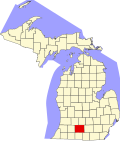Battle Creek Sanitarium | |
Formerly listed on the U.S. National Register of Historic Places | |
 Battle Creek Sanitarium headquarters, c. 1951 | |
Location in Michigan | |
 Interactive map | |
| Location | 197 N. Washington Ave., Battle Creek, Michigan |
|---|---|
| Coordinates | 42°19′37″N85°11′11″W / 42.32694°N 85.18639°W |
| Built | 1899 |
| Architect | Robert T. Newberry |
| Demolished | 1985 [1] |
| NRHP reference No. | 78001492 [2] |
| Significant dates | |
| Added to NRHP | October 4, 1978 |
| Removed from NRHP | April 18, 1988 |
The Phelps Sanitarium, later known as the Battle Creek Sanitarium, was a health care facility located at 197 N. Washington Avenue in Battle Creek, Michigan. The building was demolished in 1985. [1]


